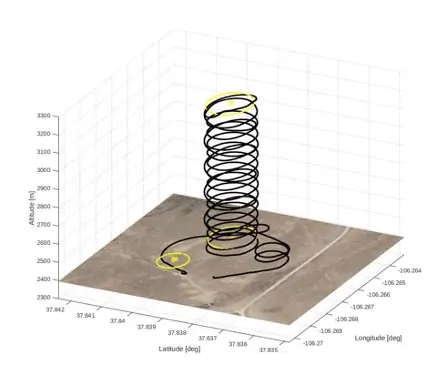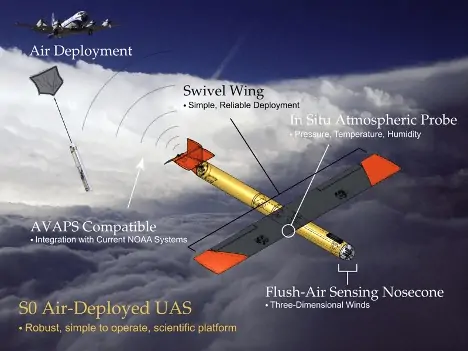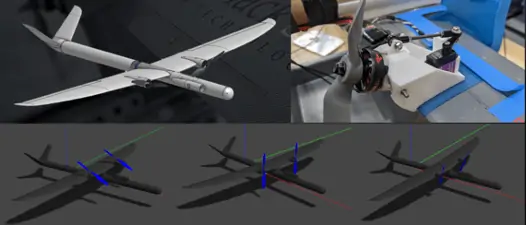The following article is based on a news released authored by the National Oceanic and Atmospheric Administration (NOAA).
Black Swift Technologies’ (BST) air-deployed S0 unmanned aerial system (UAS) is one of three small UAS platforms currently being evaluated by NOAA for use in sampling the lowest and most dangerous regions of a tropical cyclone as part of a hurricane research initiative. BST was initially awarded a Phase I SBIR (Small Business Innovation Research) grant in 2018 to determine the scientific, technical, and commercial feasibility of using such a platform for boundary layer observations in turbulent environments.
NOAA’s SBIR Program was established to support innovative research projects complementing NOAA’s core mission of science, service, and stewardship. Qualified businesses are evaluated based on their degree of innovation, technical merit, and future market potential. BST was also awarded a Phase II SBIR grant to help support the development of a commercially viable prototype.
The S0 was designed to address technical objectives defined by NOAA. The requirements included:
- Keep the price of each UAS significantly lower than similar platforms to allow for more routine operations and increased use of this technology by NOAA
- Able to measure 3D winds along with temperature, humidity, and pressure
- Deliver sea surface characterization using a laser altimeter and thermal IR sensor
- 1-2 hours of cruise flight endurance
- Integration with existing radio system used currently for dropsondes in order to stream data back to the aircraft
- A simple to use interface to pre-program the aircraft
- Provide intelligent and autonomous sampling where the aircraft can make its own navigation decisions based on atmospheric sensor data.
Critical to the success of the S0 UAS platform was Black Swift’s ability to reduce the complexity and weight of the vehicle compared with existing platforms, offering an order of magnitude decrease in cost while maintaining endurance without sacrificing performance and measurement quality. These characteristics proved to be equally valuable in the eyes of the United States Air Force when they announced an SBIR solicitation for development of a tactical weather drone able to autonomously conduct atmospheric profiling supporting more accurate cargo drops and improved localized weather forecasts for Air Force and Special Operations Forces. Unlike the UAS proposed for NOAA, which was a tube-launched variant, the USAF required a vertical takeoff and landing aircraft, yet many of the flight characteristics (such as operations in high wind speeds) mirrored that of the original S0 UAS.
The team at Black Swift evaluated their existing design and determined that, with minor alterations, the S0 could address all the requirements that the USAF outlined in their submission. The result is the Black Swift S0-VTOL, a small, ruggedized UAS capable of carrying a variety of different sensors including a full atmospheric sampling suite or small, lightweight EO/IR cameras. While the fuselage remained essentially the same, the wing structure, engine mounts and tail design all were redesigned to enable the new S0 for vertical takeoffs and landings (figure 2).
Not only did the Air Force award Black Swift Technologies the SBIR Phase I contract, they were so impressed with the solution proposed by BST that they subsequently awarded them the Phase II SBIR contract to develop their UAS design.
The S0-VTOL is an intelligent UAS designed for autonomous flights at altitudes up to 15,000 feet AGL. It has been engineered for rapid ascent and descent profiles and has custom wind estimation algorithms to allow the S0-VTOL to quickly and accurately capture 3-dimensional wind profiles. The user interface provides automated sampling patterns and high-level mission scripting all for “launch-and-forget” operations (figure 3).

Figure 3: Example flight pattern flown by the S0-VTOL to quickly determine wind speed and direction as well as other thermodynamic parameters at altitudes up to 15,000 ft. AGL
Both variants of Black Swift’s S0 were the result of funding provided through the SBIR program. This program of recognizing and rewarding technology innovation is critical to the growth and viability of small businesses like Black Swift Technologies and serves as a pathway to their future success.












